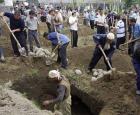Natural zone: moist equatorial forests or tropical rain forest, features, climate, soils, geographical location. Tropical forests - “the second lungs of the Earth” Temperature in tropical rainforests
Jungle, or scientifically, rainforests, from the treetops to the forest floor, are filled with life. Found here animals, about each of which you can write a separate report: a crocodile, an anteater, a hippopotamus, a bat, a sloth, a koala, a chimpanzee, a porcupine, a gorilla, an armadillo. Insects: termites, tropical butterflies, mosquitoes. Tarantula spiders, hummingbirds and parrots. Hundreds of species of plants, birds, and animals feel comfortable in the tropical forest.
Select a report about a tropical forest dweller:
What does "tropics" mean?
The tropics are the forests that grow near the equator. These forests are the most important ecosystem on Earth. The coast of the Gulf of Mexico and Brazil, the South American coasts, the islands of the West Indies, part of Africa, the island of Madagascar, and some Asian countries and islands Pacific Ocean- occupied by tropical thickets. The tropics make up only 6 percent of the landmass.

High humidity and hot climate- the main features of the fabulous diversity of forms of local life. Constant warmth, frequent, heavy, short-lived tropical downpours contribute to rapid growth and flora development. And the fauna, thanks to the abundance of water, also does not suffer from drought. Tropical forests have red or spotted soils, and the forest itself is multi-tiered, with each level densely populated. Such a diversity of flora and fauna is possible due to ideal living conditions.
Who lives in the tropical forest and how?
The wilds of the forest are inhabited by a variety of animals. Giant elephants and small insects, birds and animals of medium size, can live simultaneously in one area of the forest, but at different levels, finding shelter and food in the forests. No other place on land has such a wealth of ancient life forms - endemics. Thanks to the dense foliage cover, the undergrowth in the rainforest is weak and animals can move freely.
The diversity of animals in the tropical forests is amazing: along with reptiles (turtles, crocodiles, lizards and snakes), there are many amphibians. The abundance of food attracts herbivores. Predators come after them (leopards, tigers, jaguars). The color of the inhabitants of the tropics is rich, since spots and stripes help to better camouflage in the forest. Many types of ants, tropical butterflies and spiders provide food for hundreds of bird species. The tropics are home to the largest number of monkeys on the planet; there are more than one and a half hundred parrots and 700 species of butterflies, including giant ones.

Unfortunately, many representatives of the jungle fauna (antelope, rhinoceroses, etc.) were exterminated by humans during colonialism. Now many animals that previously lived freely in tropical forests remain only in nature reserves and zoos. Human destruction of forests leads to a reduction in fauna and flora, soil erosion, and loss of the ecological balance of our planet. Rainforests- “the green lungs of the planet” - have been sending us a message for decades now, signaling that a person must be responsible for his actions.
If this message was useful to you, I would be glad to see you
World of flora tropical forests has a huge variety. Among the trees that grow on the coasts you can find a coconut palm. Their fruits, coconuts, are very useful and are used in cooking and cosmetology.
Here you can meet different types banana plants, which people use as fruits and vegetables, depending on the stage of ripening.
banana plant

One of tropical plants is mango, among which the most famous is the Indian mango.

The melon tree, better known as papaya, grows in forests and is of great economic importance.
Melon tree, papaya

Breadfruit is another representative of forests where nutritious fruits are highly valued.

One of the mulberry family is marang.

The durian plant can be found in tropical rainforests. Their flowers grow directly on the trunks, and their fruits are protected by spines.

Morinda citrusifolia is native to South Asia and has edible fruit that is part of the diet of some Pacific Islanders.

Pitaya is a vine-like rainforest cactus that has sweet and edible fruits.

One of the interesting tropical plants is the rambutan tree. It reaches a height of 25 meters and is evergreen.
Rambutan

Small evergreen guava trees grow in tropical forests.

Fast growing evergreen tropical tree Persea americana is nothing more than an avocado plant that is found in many forests.
Perseus americana, avocado

Various types of ferns, mosses and lichens, lianas and epiphytes, bamboos, sugar cane, and cereals grow in tropical forests.








Rainforest levels
Typically, a tropical forest has 4-5 tiers. At the top, trees grow up to 70 meters. These are evergreen trees. In seasonal forests they shed their leaves during dry periods. These trees protect the lower levels from wind, precipitation and cold. Next, the crown tier (canopy) begins at a level of 30-40 meters. Here the leaves and branches fit together very tightly. It is very difficult for people to reach this height in order to explore the world of flora and fauna of the canopy. They use special techniques and aircraft. Average level forests are undergrowth. A unique living world has formed here. Then comes the bedding. These are various herbal plants.

The flora of tropical forests is very diverse. Scientists have not yet studied these forests much, since they are very difficult to navigate. In the future, new plant species will be discovered in tropical forests.
Rainforests located in the tropical, equatorial and subequatorial zones between 25° north latitude. and 30° S, as if “surrounding” the surface of the Earth along the equator. Rainforests are broken only by oceans and mountains.
The general circulation of the atmosphere occurs from a zone of high atmospheric pressure in the tropical region in the zone low pressure in the equator region, evaporated moisture is transferred in the same direction. This leads to the existence of a humid equatorial zone and a dry tropical one. Between them there is a subequatorial belt, in which moisture depends on the direction of the monsoons, depending on the time of year.
The vegetation of tropical forests is very diverse, depending mainly on the amount of precipitation and its distribution over the seasons. When abundant (more than 2000 mm), and relatively uniform distribution develop tropical humid evergreen forests.
Further from the equator, the rainy period gives way to a dry period, and forests are replaced by leaves falling during drought, and then these forests are replaced by savanna forests. At the same time, in Africa and South America there is a pattern: from west to east, monsoon and equatorial forests are replaced by savanna forests.
Classification of tropical forests
Tropical rainforest, tropical rain forest these are forests with specific biomes located in equatorial (equatorial rainforest), subequatorial and humid tropical areas with a very humid climate (2000-7000 mm of precipitation per year).
Tropical rainforests are characterized by enormous biodiversity. This is the most conducive to life natural area. Lives here a large number of own, including endemic species of animals and plants, as well as migratory animals. Two-thirds of all animal and plant species on the planet live in tropical rainforests. It is estimated that millions of animal and plant species remain undescribed.
These forests are sometimes called " jewels of the earth" And " the largest pharmacy in the world", since a large amount of natural medical supplies. They are also called " lungs of the Earth“However, this statement is controversial because it has no scientific basis, since these forests either do not produce oxygen at all or produce extremely little of it.
But it should be borne in mind that a humid climate promotes effective air filtration due to the condensation of moisture on microparticles of pollution, which has a generally beneficial effect on the atmosphere.
Understory formation in tropical forests is severely limited in many places due to the lack of sunlight in the understory. This allows humans and animals to move through the forest. If for some reason the deciduous canopy is absent or weakened, the lower tier is quickly covered with a dense thicket of vines, shrubs and small trees - this formation is called a jungle.
The most large areas tropical rain forests are found in the Amazon River Basin (“Amazon rain forest”), in Nicaragua, in the southern part of the Yucatan Peninsula (Guatemala, Belize), in most of Central America (where they are called “selva”), in equatorial Africa from Cameroon to Democratic Republic Congo, in many areas South-East Asia from Myanmar to Indonesia and New Guinea, in the Australian state of Queensland.
For tropical rainforests characteristic:
- variety of flora,
- presence of 4-5 tree layers, absence of shrubs, large number of vines
- predominance of evergreen trees with large evergreen leaves, poorly developed bark, buds not protected by bud scales, in monsoon forests– deciduous trees;
- the formation of flowers and then fruits directly on trunks and thick branches
Trees in tropical rainforests have several general characteristics, which are not observed in plants of less humid climates.
The base of the trunk in many species has wide, woody projections. Previously it was assumed that these protrusions help the tree maintain balance, but now it is believed that along these protrusions there is water with dissolved nutrients flows down to the roots of the tree. The broad leaves of trees, shrubs and grasses of the lower tiers of the forest are characteristic. Wide leaves help plants absorb better sunlight There are forests under the edges of the trees, and they are protected from the wind from above.
Tall young trees that have not yet reached the top tier also have wider foliage, which then decreases with height. The leaves of the upper tier, which form the canopy, are usually smaller and heavily cut to reduce wind pressure. On the lower floors, the leaves are often narrowed at the ends so that this facilitates the rapid drainage of water and prevents the growth of microbes and moss on them, which destroy the leaves.
Tree tops are often very well connected with each other using vine or epiphytic plants, fixed on them.
The trees of the tropical rainforest are characterized by unusually thin (1-2 mm) tree bark, sometimes covered with sharp thorns or prickles, the presence of flowers and fruits growing directly on the tree trunks, and a wide variety of juicy fruits that attract birds and mammals.
In tropical rainforests there are a lot of insects, especially butterflies (one of the richest faunas in the world) and beetles, and in rivers there are a lot of fish (about 2000 species, approximately a third of the world's freshwater fauna).
Despite the lush vegetation, the soil in tropical rainforests is thin and has a small humus horizon.
Rapid rotting caused by bacteria prevents the accumulation of a humus layer. The concentration of iron and aluminum oxides due to laterization Soil dehydration (the process of reducing silica in the soil while increasing iron and aluminum oxides) turns the soil bright red and sometimes forms mineral deposits (such as bauxite). But on rocks of volcanic origin, tropical soils can be quite fertile.
Levels (tiers) of tropical rainforest
The rainforest is divided into four main levels, each of which has its own characteristics and has different flora and fauna.
Top level
This tier consists of small quantity Very tall trees, rising above the forest canopy, reaching a height of 45-55 meters ( rare species reach 60-70 meters). Most often the trees are evergreen, but some shed their leaves during the dry season. Such trees must withstand harsh temperatures and strong winds. Eagles live on this level, the bats, some species of monkeys and butterflies.
Crown level (forest canopy)
The crown level is formed by most tall trees, usually 30-45 meters high. This is the densest layer known in all of Earth's biodiversity, with neighboring trees forming a more or less continuous layer of foliage.
According to some estimates, plants of this tier make up approximately 40 percent of the species of all plants on the planet - perhaps half of the entire flora of the Earth can be found here. The fauna is similar to the upper level, but more diverse. It is believed that a quarter of all insect species live here.
Scientists have long suspected the diversity of life at this level, but only recently have they developed practical research methods. It was not until 1917 that the American naturalist William Beed declared that “another continent of life remains unknown, not on the earth, but 200 feet above its surface, extending over thousands of square miles.”
Real exploration of this layer only began in the 1980s, when scientists developed techniques to reach the forest canopy, such as shooting ropes into the treetops with crossbows. Forest canopy research is still in its early stages. Other research methods include travel on balloons or aircraft. The science of reaching treetops is called dendronautics.
Average level
Between the forest canopy and the forest floor there is another level called the understory. It is home to a number of birds, snakes and lizards. Insect life at this level is also very extensive. The leaves in this tier are much wider than at the crown level.
forest floor
IN Central Africa in the tropical primary forest of Mount Virunga, illumination at ground level is 0.5%; in the forests of southern Nigeria and in the Santarem region (Brazil) 0.5-1%. In the north of the island of Sumatra in the dipterocarp forest, the illumination is about 0.1%.
Far from the banks of rivers, swamps and open spaces where dense, low-growing vegetation grows, forest floor relatively free of plants. At this level you can see rotting plants and animal remains, which quickly disappear thanks to the warm, humid climate, promoting rapid decomposition.
Selva(Spanish: " selva" from lat. " silva"- forest) is equatorial rainforests in South America. Located in countries such as Brazil, Peru, Suriname, Venezuela, Guyana, Paraguay, Colombia, etc.
The selva is formed on vast low-lying areas of land under conditions of constant freshwater moisture, as a result of which the soil of the selva is extremely poor in minerals washed away by tropical rains. Selva is often swampy.
The flora and fauna of the selva is a riot of colors and a variety of species of plants, birds and mammals.
The largest village in terms of area is located in the Amazon basin in Brazil).
In the Atlantic jungle, precipitation reaches two thousand millimeters per year, and humidity fluctuates at 75-90 percent.
The village is divided into three levels. The soil is covered with leaves, branches, trunks of fallen trees, lichens, fungus and moss. The soil itself is reddish in color. The first level of the forest consists of low plants, ferns and grass. The second level is represented by shrubs, reeds and young trees. On the third level there are trees from twelve to forty meters high.
Mangroves – evergreen deciduous forests, common in the tidal zone sea coasts in tropical and equatorial latitudes, as well as in areas with temperate climate, where it is favorable warm currents. They occupy the band between the lowest water level at low tide and the highest at high tide. These are trees or shrubs growing in mangroves, or mangrove swamps.
Mangrove plants live in sedimentary coastal environments where fine sediments, often high in organic matter, accumulate in areas protected from wave energy.
Mangroves have an exceptional ability to exist and develop in a saline environment on soils deprived of oxygen.
Once established, mangrove plant roots create habitat for oysters and help slow water flow, thereby increasing sedimentation in areas where it is already occurring.
As a rule, fine, oxygen-poor sediments under mangroves act as reservoirs for a wide variety of heavy metals (trace metals), which are captured from sea water colloidal particles in sediments. In those areas of the world where mangroves were destroyed during the development of the territory, the violation of the integrity of these sedimentary rocks gives rise to the problem of heavy metal contamination of sea water and local flora and fauna.
It is often stated that mangroves are of significant value in coastal zone, acting as a buffer against erosion, the onslaught of storms and tsunamis. Although there is a definite reduction in wave height and wave energy as seawater passes through mangroves, it must be recognized that mangroves typically grow in those areas coastline, where low wave energy is the norm. Therefore, their ability to withstand the powerful onslaught of storms and tsunamis is limited. Their long-term impact on erosion rates is also likely to be limited.
Many river channels meandering through mangrove areas actively erode the mangroves on the outside of all river bends, just as new mangroves appear on the inside of the same bends where sedimentation occurs.
Mangroves provide habitat for wild animals, including a number of commercial species fish and crustaceans, and in at least some cases the export of stored carbon by mangroves is important in the coastal food web.
In Vietnam, Thailand, the Philippines and India, mangroves are grown in coastal areas for inshore fisheries.
Despite ongoing mangrove breeding programs, More than half of the world's mangroves have already been lost..
The floristic composition of mangrove forests is relatively uniform. Mangrove forests of the eastern formation (the shores of the Malacca Peninsula, etc.) are considered the most complex, tall and multi-species.
Misty forest (moss forest, nephelogia) – tropical moist montane evergreen forest. Located in the tropics on the slopes of mountains in a zone of fog condensation.
The foggy forest is located in the tropics on the slopes of mountains in a zone of fog condensation, usually starting at altitudes of 500-600 m and reaching heights of up to 3500 meters above sea level. It is much cooler here than in the jungles located in low-lying areas; at night the temperature can drop to almost 0 degrees. But it’s even more humid here, one year a year square meter Up to six cubic meters of water falls. And if it doesn’t rain, then the moss-covered trees stand shrouded in fog caused by intense evaporation.
Foggy forest formed by trees with abundant lianas, with a dense cover of epiphytic mosses.
Tree ferns, magnolias, camellias are characteristic; the forest may also include non-tropical vegetation: evergreen oaks, podocarpus, which distinguishes this type of forest from lowland gils
Variable tropical rainforests- forests common in tropical and equatorial belts, in a climate with a short dry season. Located south and north of the wetlands equatorial forests. Variably humid forests are found in Africa (CAR, DR Congo, Cameroon, northern Angola, extreme south of Sudan), South America, India, Sri Lanka, and Indochina.
Variable rainforests are partly deciduous, dense tropical forests. They differ from humid tropical forests in lower species diversity and in the reduced number of epiphytes and lianas.
Dry tropical evergreen forest. Located in areas with arid climate, while remaining dense and evergreen, they become stunted and xeromorphic.
HUMAN IMPACT ON TROPICAL FORESTS
Contrary to popular belief, tropical rainforests are not major consumers carbon dioxide and, like other established forests, are carbon neutral.
Recent studies show that most rain forests, on the contrary, are intensively produce carbon dioxide, and swamps produce methane.
However, these forests play a significant role in the circulation of carbon dioxide because they are established reservoirs, and cutting down such forests leads to an increase in carbon dioxide in the Earth's atmosphere. Tropical rainforests also play a role in cooling the air that passes through them. That's why tropical rainforests - one of the most important ecosystems on the planet, the destruction of forests leads to soil erosion, a reduction in species of flora and fauna, and shifts in the ecological balance over large areas and on the planet as a whole.
Tropical rainforests They are often used for plantations of cinchona and coffee trees, coconut palms, and rubber trees. In South America, tropical rainforests are also seriously threatened by unsustainable mining.
A.A. Kazdym
List of used literature
- M. B. Gornung. Constantly humid tropics. M.: “Thought”, 1984.
- Hogarth, P. J. The Biology of Mangroves. Oxford University Press, 1999.
- Thanikaimoni, G., Mangrove Palynology, 1986
- Tomlinson, P. B. The Botany of Mangroves, Cambridge University Press. 1986:
- Jayatissa, L. P., Dahdouh-Guebas, F. & Koedam, N. A review of the floral composition and distribution of mangroves in Sri Lanka. Botanical Journal of the Linnean Society, 138, 2002, 29-43.
- http://www.glossary.ru/cgi-bin/gl_sch2.cgi?RSwuvo,lxqol!rlxg
.
.
.
DID YOU LIKE THE MATERIAL? SUBSCRIBE TO OUR EMAIL NEWSLETTER:
Every Monday, Wednesday and Friday we will send you an email digest of the most interesting materials on our site.
The most useful plants tropical forests, Exotic fruits, medicinal plants. Encyclopedia of the 54 most interesting species plants that can be useful to humans in tropical rainforests. ATTENTION! I recommend that all unfamiliar plants be considered poisonous by default! Even those that you are simply not sure about. Tropical rainforests are the most diverse ecosystem on our planet, and therefore here I have collected only those plants that can be useful to humans in any way.
1) Coconut tree

Sea coast plant that prefers sandy soils. In a lot useful substances: vitamins A, C and group B; minerals: calcium, sodium, potassium, phosphorus, iron; natural sugars, proteins, carbohydrates, fatty oils, organic acids. Coconut milk often used as an alternative to physical solution for its high content various salts and microelements. Coconut milk will help you regulate the body's salt balance.
- Coconut palm has a reputation as a strong aphrodisiac and normalizes the functioning of the reproductive system. Milk and coconut pulp restore strength well and improve vision;
- Improve work digestive system and liver;
- Normalize thyroid function;
- Relaxes muscles and helps with joint problems;
- Increase immunity and resistance to various infections, reduce the adaptability of bacteria to antibiotics;
- Coconut pulp and oil, thanks to the lauric acid they contain (this is the main fatty acid found in breast milk), normalize cholesterol levels in the blood;
- Helps the body with flu and colds, AIDS, diarrhea, lichen and gallbladder diseases
- They have anthelmintic, antimicrobial, antiviral wound healing effects;
- Reduce the risk of atherosclerosis and other diseases of cardio-vascular system, as well as cancer and degenerative processes.
ATTENTION! A fall coconut on the head can be fatal! This is the cause of death for many people!
2) Banana

If you want to quickly restore reduced level energy of your body - there is no better snack than a banana. Studies have proven that just two bananas provide enough energy for 1.5 hours of vigorous work. Good food product, due to the high amount of carbohydrates it contains, it can be eaten instead of the potatoes we are used to. Helps with many diseases, such as anemia, ulcers, reduces blood pressure, improves mental capacity, helps with constipation, depression, heartburn. The peel helps get rid of warts. One banana contains on average 60-80 calories. Banana contains: chemical elements, like iron, potassium, sodium, magnesium, phosphorus and calcium. By eating 2 bananas during the day, you will replenish the body's need for potassium and two-thirds for magnesium. In addition, bananas contain vitamins A, B1, B2, B3, B6, B9, E, PP. The substance ephedrine contained in bananas, when consumed systematically, improves the activity of the central nervous system. nervous system, and this directly affects overall performance, attention and mood.
3) Papaya

Papaya leaves, depending on their age, processing method and, in fact, the recipe itself, are used to reduce high blood pressure, treat kidney infections, stomach pain and intestinal problems. Papaya fruits are used in the treatment of fungal diseases and ringworm. Papaya fruits and leaves also contain the alkaloid carpaine, which has an anthelmintic effect, which can be dangerous in large doses. Papaya fruits are not only appearance, but also by chemical composition very close to melon. They contain glucose and fructose, organic acids, proteins, fiber, beta-carotene, vitamins C, B1, B2, B5 and D. Minerals are represented by potassium, calcium, phosphorus, sodium, iron.
4) Mango

Mangoes normalize intestinal function; two green mangoes a day will protect you from diarrhea, constipation, hemorrhoids, and will also prevent bile stagnation and disinfect the liver. When eating green fruits (1-2 per day), the elasticity of blood vessels improves, due to the high iron content in the fruits; mango is useful for anemia. And the high content of vitamin C makes it an excellent remedy for vitamin deficiency. Eating more than two unripe fruits per day may cause colic and irritation of the gastrointestinal tract and throat mucosa. Overeating ripe fruits can lead to intestinal upset, constipation, allergic reactions. Mango contains a large amount of vitamin C, B vitamins, as well as vitamins A, E, and contains folic acid. Mango is also rich in minerals such as potassium, magnesium, and zinc. Regular consumption of mangoes strengthens the immune system. Due to the content of vitamins C, E, as well as carotene and fiber, eating mango helps prevent colon and rectal cancer, and is a prevention of cancer and other organs. Mango is an excellent antidepressant, improves mood, and relieves nervous tension.
The equatorial rain forests are home to some of the richest flora in the world, as well as a huge storehouse of valuable wood, many useful and medicinal plants. Due to the difficult terrain, the vegetation of tropical forests has not yet been studied enough. Scientists have found that over 20 thousand flowering plants and about 3 thousand tree species. Forests South America have a richer flora than in Africa and Southeast Asia.
General characteristics of the vegetation of equatorial forests
The tropical forest has a complex multi-tiered structure. The trees are distinguished by weakly branching, tall trunks with poorly developed bark, reaching up to 80 m in height and having elongated plank-shaped roots at the base. Most trees are densely entwined with vines.
Mid-tier plants and shrubs have wide leaves that help them absorb light sun rays under the dense canopies of taller trees. The surface of the leaves is mostly leathery, shiny and dark green in color. The grass cover under the forest canopy is represented by subshrubs, mosses and lichens. Another one characteristic feature tropical vegetation- thin tree bark with fruits and flowers growing on it.


Let's take a closer look at some plants of humid equatorial forests:
The vegetation is represented by a huge variety of extra-tiered plants - epiphytes and lianas. More than 200 species of palms and ficus trees, about 70 species of bamboo plants, 400 species of ferns and 700 species of orchids grow here. Vegetable world the tropics differs in different continents. In the tropics of South America, ficus and palm trees, bananas, hevea brasiliensis, and fragrant cedrela grow widely (cigarette cases are made from its wood). Ferns, vines and shrubs grow in the lower tiers. Of the epiphytes, orchids and bromeliads are widely found. In African tropical forests, the most common trees are the legume family, the coffee tree and the cocoa tree, as well as the oil palm.


Lianas. The most famous representatives of the tropical forest flora. They are distinguished by strong and large woody stems, reaching a length of over 70 m. Among them, the most interesting are the bamboo vine with shoots up to 20 m long, the medicinal strophanthus vine, as well as the poisonous physostigma, which grows in West Africa. The legumes of this vine contain physostigmine, which is used for glaucoma.

Ficus stranglers. The seeds germinate, falling into the crevices of the trunks. The roots then form a dense framework around the host tree that keeps the ficus alive, inhibiting its growth and causing its death.
Hevea brasiliensis. Rubber, extracted from the milky sap of the tree, accounts for about 90% of its production in the world.
Ceiba. It reaches a height of up to 70 m. Oil for soap production is obtained from the seeds, and cotton fiber is extracted from the fruits, which is used to stuff upholstered furniture, toys and are used for heat and sound insulation.

Oil palm. “Palm oil” is extracted from its fruits, from which candles, margarine and soap are made, and sweet juice drinking in fresh or used for the production of wines and alcoholic beverages.








 Osh events. Osh conflict. There is a war going on - the Great Kyrgyz Patriotic War
Osh events. Osh conflict. There is a war going on - the Great Kyrgyz Patriotic War Reflection in accounting of accepted budgetary obligations
Reflection in accounting of accepted budgetary obligations Lenten muffin recipes Lenten baking with cocoa
Lenten muffin recipes Lenten baking with cocoa Why do you dream of being a beggar?
Why do you dream of being a beggar?